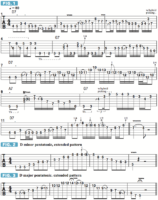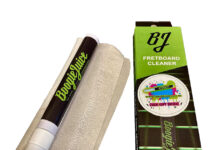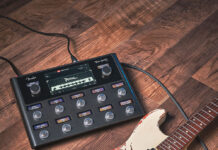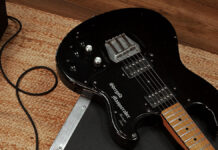
How to Create Flowing, Stylish Licks Like Eric Clapton
When it comes to spontaneous, improvised phrasing, there is perhaps no better blues-rock guitarist than Eric Clapton, especially when heard within the context of the many extended jams he performed with Cream and Blind Faith.
He has the innate ability to move smoothly from one great, imminently melodic phrase into the next while also both riding the groove and pushing it along.
When improvising, Clapton will subtly mix up the rhythms of his lines to create clearly defined syncopations that serve to strengthen the melodic quality of his solos.
FIGURE 1 presents an extended solo that moves through an entire 12-bar blues progression in the key of D, the three chords being D7, G7 and A7. The tempo is a fairly slow 80 beats per minute, which allows for the steady articulation of 16th-note rhythms that employ subtle phrasing variations. In bars 1–3, I stick with the notes from the D minor pentatonic scale (D F G A C).
At the end of bar 3, I transition to sliding sixth intervals by sounding pairs of notes that are six scale degrees apart within the D Mixolydian mode (D E F# G A B C), with all of the notes played on the D and B strings. This sets up the move to the four chord, G7, in bar 5, and here I play a simple melody based on G minor pentatonic (G Bb C D F), returning to D minor pentatonic in bar 6 to anticipate the change back to the one chord, D7, in bar 7.
On beat three of bar 7, I make very brief reference to the parallel D major pentatonic scale (D E F# A B), used to add some brightness and warmth to the melody and also as a transition to get back into D minor pentatonic in 10th position.
Alternating between parallel minor and major pentatonic scales is a standard technique used by all blues guitar greats, such as T-Bone Walker, B.B. King, Buddy Guy and many others, and Clapton learned this technique from his intense study of the recordings of all of these masters and made it one of the hallmarks of his unique style.
Bar 9 moves to the five chord, A7, and bar 10 shifts to the four chord, G7, and for each of these chords I base my lines on the associated minor pentatonic scales (A minor pentatonic: A C D E G). At the return to the tonic in bars 11 and 12, I revert to D minor pentatonic and move freely between third and fifth positions. When playing these melodic shapes and ideas, strive for smooth articulation and, as always, listen closely to the many great live recordings of Cream—and the studio recordings of Blind Faith—to hear priceless examples of Clapton’s stellar soloing.
FIGURES 2 and 3 illustrate extended patterns for D minor pentatonic and D major pentatonic, so be sure to study these too.
Source: www.guitarworld.com











